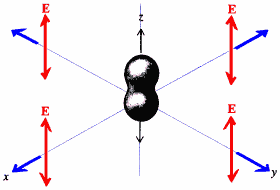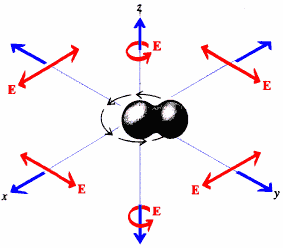![[ Image of 2p (m=0) to 1s coherent state
oscillations over one period (one wavelength of radiation) ]](1s2p0anim.gif)
How does the excited state decay ?
How is radiation produced during the transition ?
however the initial and final quatum states are stationary states in which the electron probability density is absolutely time independent, how is radiation if the electron is no longer localized to a point ? However as we shall see the system is coupled to the electromagnetic field, and even in the absence of external influences such as an applied field produced by incomming photons; we shall see that if we quatize the electron we must aslo quantize the photon; during the quantization we find that the lowest state of the electromagnetic feild, i.e. the vacuum or ground state in which there are zero photons still produces a non-zero electromagnetic field or zero-point radiation.
The tools of quantum mechanics will enable us to describe in a certain fashion what occurs to an atom when it emits a photon.
In this case observation of a quantum property described by a hermitian operator can only produce observational results which correspond the discrete eigenvalues of the operator. Thus our box can only determine if the atom is in state 2 or in state 1.
However as Einstein and Heisenberg have discovered, light can be thought of as both a particle and a wave. Thus particles obey the laws of quantum mechanics and must be quantized. It is in the process quantizing the electromagnetic field that we discover that the vacuum has non-zero fluctuations called 'zero-point-field-fluctuations' or vacuum fluctuations. They correspond to the lowest state of a harmonic oscillator, which has a finite energy E=(n+1/2)hw, where n=0.
This has enormous implications concerning the stability of stationary states, which can, even in principle, no longer be considered as free from pertubations. An excited state can no longer be considered stationary, a quantized electromagnetic field term must be added to the Hamiltonian. Even if no external field is applied on the system, there remains the zero-point fluctuations which causes irreversible decay of the upper excited state. This is the process of spontaneous emission which can be regarded as stimulated emission by the vacuum field fluctuations.
Phi(x,t) = c1(t) Phi1(x) + c2(t) Phi2(x)
If we compute the expectation value of the position projection |x >< x| operator on this hybrid state we can obtain the electron probability density at any given time. When Phi(x,t) is squared we obtain a sum of the three dimensional probability density of the upper state Phi2(x)2 times c2(t)2, the probability of being in the upper state, plus the probability density of the lower state Phi1(t)2 times c1(t)2 the probability of being in the lower state,
During the coherent superposition a dipole moment is produced by the quantum interference of the of the amplitudes; the charge density distribution oscillates about the nucleus; as depicted by the flow of electron probability currents up and down across the nucleus in the m=0 to m=0 transitions of a hydrogen atom undergoing the transition from the 2p (m=0) to 1s transition (Lyman-alpha transition), as can be seen from the following diagram of football-shaped oscillations.
![[ Image of 2p (m=0) to 1s coherent state
oscillations over one period (one wavelength of radiation) ]](1s2p0anim.gif)
Evolution of electron probability distribution for the 2p (m=0) + 1s coherent state, this sequence of oscillations span one complete period of the emerging radiation. Each successive frame of this animation has evolved in time by one quarter period, producing vertical oscillations akin to 'blobby deflating football'
After one 'Bloch Oscillation' the probability for being in the upper state is slightly lower than the probability of being in the lower state, in accord with the law of conservation of energy which states that the energy gained by the radiation field during one oscillation must be counterbalanced by an equivalent loss of energy by the quantum system.
In the coherent state corresponding to the m=±1 to m=0 transition, the probabily current flows mostly in circular orbits, as is obvious from the rotating dumbell of the following diagram.
![[ Image of 2p(m=±1) to 1s coherent state
oscillations over one period (one wavelength of radiation) ]](1s2p1anim.gif)
Same type of animation as above, however the state is now the 2p(m=±1) + 1s coherent superposition, producing a rotating 'dumbell' pattern
From conservation of total probability, the divergence of the probability density current is proportional the the time rate of change of the probability density. The electron cloud behaves like a fluid with well defined conservation laws. Hence the appearance of probability density function of the coherent state during the emission of radiation resembles the hydrodynamical laws of tiny oscillating fluid dropplets.
To compute the strenght of the electromagnetic radiation emitted we take the expectation of the dipole moment operator, we then find that it is proportional to the amount of overlap between the upper and lower states, which becomes maximal when the probability of being in the upper state is equal to the probability density of being in the lower state. This is equivalent to the largest possible product c1(t)c2*(t) which obeys the constraint 1=c12(t) + c22(t); thus maximizing the interference cross terms.
This temporary dipole produces radiation of the same frequency as the oscillation frequency : Although it is stated without proof in most texts, quantum interference is the main reason why the emitted radiation is proportional to the difference in energy between the upper and lower quantized states.
The state of the system can be represented as a bloch vector, a unit vector which spins around on the surface of a sphere whose azimuthal angle with respect to the x-axis represent the dipole phase, and whose projection on the z-axis represented population inversion levels.
[IMAGE of Bloch vector representation of Coherent Superposition State]
This diagram representation is important for the explanation various quantum optical effects such as photon echos, self-induced transparency, pi-pulse inversion and in Electromagnetically Induced Transparency (EIT). All of which rely heavily on subtle interference effects that are very sensitive to the quantum phase of the dipoles.
In the case of spontaneous emission the probability of being in the upper state is proportional the the square of c2(t), it decays exponentially by an irreversible process which couples a discrete state to a continuum of final states.
[ PLOT of exponential probability decay of upper quantum state in spontaneous emission ]
If we neglect decay, then the case of stimulated emission and/or absorption produce probability amplitudes which oscillate sinusoidally betwen beeing in the upper state and beeing in the lower state, but this discussion is deferred to a laster section on stimulated emission.
[ PLOT of sinusoidal oscillation of probability in stimulated emission/absorption]
The initial discrete state can be considered as a tensor product of an excited electron plus no photon (vacuum). The final continuum of states is the tensor product of the de-excited electron plus one photon quantum with arbitrary direction and polarization. The frequency of the quantum has an intrinsic fuzziness owing to the finite lifetime of the excited state; if many decays are observed, their distribution plotted as a function of energy is a lorentzian whose linewidth is inversely proportional to decay rate. (we neglect Doppler motions as these can easily be made negligible compared to natural broadening)
[ PLOT of natural lorentzian emission line profile ]

Radiation pattern (blue arrows) of an oscillating electron probability density
distribution during the transition from the 2p(m=0) to the 1s state. The vertical
direction of polarization is indicated by the red arrows labeled with 'E' for
'Electric' field. No radiation emerges along the z-axis. The maximum radiation
occurs in the xy plane.

Radiation pattern and polarization of an oscillating electron probability density
distribution during the transition from the 2p(m=±1) to the 1s state.
The radiation emerging along the z-axis is completely circularly polarized
while the radiation emitted in the xy plane is linearly polarized. Intermediate
directions produce elliptical polarizations.
The patterns we are referring to are based on the semi-classical radiation approximation, where the electromagnetic field is not quantized. This can be viewed wihthin the quantized photon formalism only if we treat the radiation pattern as a probabilty amplitude for photon emission in a particular direction. Also, we must be very careful to describe what we mean by photon polarization : A single photon, being a spin one boson moving at the speed of light is limited to either left or right handed circular polarization or helicity. Therefore we can only construct linear and elliptical polarization by suitable superpositions of amplitudes of left and right circular polarizations. However with the correct phase and relative magnitude, any arbitrary polarization can be contructed from the basis of left and right handed circular polarization.
Therefore it comes as no surprise that recent improvements in lasers technology is entirely due to a better knowledge and control of the precise atomic interference effects of coherent states. Electromagnetically Induced Transparency (EIT) and Lasing Without Inversion (LWI) are a product of a detailed consideration of the phases of the induced dipoles within coherent states. Until recently dipole phase has been ignored in favour of the easier thermodynamic viewpoint which only considers the net population difference between the upper and lower state and disregards the coherences between various quantum levels.
The new field of atomic interference effects is like a double slit diffraction experiment, analogy :